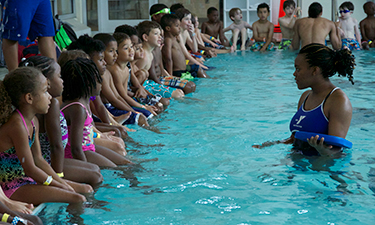 According to the Centers for Disease Control, drowning ranks fifth among the leading causes of unintentional injury or death in the United States. About one in five individuals who die from drowning are children age 14 or younger. The fatal drowning rate of African-American children ages 5–14 is almost three times that of white children in the same age range. These are grim statistics, but they help to underscore the universal importance of learning basic swimming skills. Organizers of the World’s Largest Swimming Lesson hope their annual event helps lower those numbers while bringing communities together for fun and a potentially life-saving education.
According to the Centers for Disease Control, drowning ranks fifth among the leading causes of unintentional injury or death in the United States. About one in five individuals who die from drowning are children age 14 or younger. The fatal drowning rate of African-American children ages 5–14 is almost three times that of white children in the same age range. These are grim statistics, but they help to underscore the universal importance of learning basic swimming skills. Organizers of the World’s Largest Swimming Lesson hope their annual event helps lower those numbers while bringing communities together for fun and a potentially life-saving education.
The simple enjoyment of splashing around with friends and family at the local pool is a particularly alluring aspect of WLSL, but of utmost importance is the effort to reduce rates of drowning deaths and injuries. “We were looking for a cornerstone opportunity we could give to the larger aquatics community to rally around, build media coverage at the start of swimming season and contribute to the anti-drowning movement,” says Aleatha Ezra, director of park member development at the World Waterpark Association, which founded and each year organizes WLSL. “Creating this event gives facilities a one-day, big-impact opportunity to spread the word about water safety and help prevent drownings. It’s an out-of-the-box piece people can use to get media coverage around this important safety initiative.”
WLSL launched in 2010, and during the past four years, Ezra believes organizers have hit on a winning combination to get more aquatics facilities involved — namely, fun, community and safety. The driving principle behind the event has always been education and drowning prevention, but adding the allure of taking part in a Guinness Book of World Records challenge has generated even more buzz. WWA members met with Guinness representatives to develop guidelines for achieving the distinction of hosting the world’s largest simultaneous swimming lesson. “[The award] did not exist before we created the event,” Ezra says. “Another organization or group could try for the record, too, but so far it’s only ever been our group that has gone after it. We have four records and this year we’ll be going for our fifth.”
Guidelines to win the record include that classes begin at the same time and be of a certain length, the same curriculum must be taught to all participants, and facility managers are required to provide adequate documentation for their swim lesson to count toward the overall total. “The curriculum is not meant to be a comprehensive swim lesson,” Ezra clarifies. “It won’t take someone who never has swum and teach them in 30 minutes, but it does cover essentials like how to follow rules, how to enter the water safely, breathing and submerging, holding your breath under water, floating skills, how to roll from front to back, basic strokes, kicking at the wall and front-gliding with a partner.” The lesson’s simple format, plus the opportunity to become a world-record holder and enjoy a fun time at the pool, has increased WLSL’s participation rates steadily since the event’s inception. In 2013, 32,450 individuals at 432 facilities spread across 13 countries participated in the lesson, representing a 30 percent increase from 2012.
Pools and other aquatic facilities are often viewed as gathering places for the community, and WLSL seeks to truly capitalize on that sense of familiarity in emphasizing a feeling of freedom and belonging that might encourage tentative individuals to give swimming a try. That philosophy applies to children and adults, and Ezra believes it’s key to spreading the message of water safety as widely as possible. “[WLSL] is a water-safety event that is easy to promote and spreads the word across multiple media outlets,” Ezra says. “It brings the community together over generations — grandma, mom, dad, kids — they may not all be part of the lesson, but they’ll watch, they’ll tweet about ‘my kid is a world-record holder.’ It spreads on a grassroots level and reaches so many people.”
Stephanie Hee, marketing specialist at NRH20 Family Waterpark with the City of North Richland Hills Parks and Recreation Department in Texas, noticed how the inclusive group lesson inspired confidence among individuals at her facility. “Swimming lessons give all participants confidence,” she says. “They realize they’re not the only ones who don’t know how to swim. It’s a relief once kids see there are some who don’t know how to swim at all, and others who are very experienced swimmers. We don’t care what their [experience] level is — not only are we teaching them swimming basics, we want to constantly remind them how important it is to learn to swim so they spread the word.”
And spread the word they do — Hee says that each year, positive responses from her community roll in post-WLSL. “We constantly hear how thankful [people] are to have this offered,” she says, noting there’s still more to do in the fight against drowning:
“I wish we could have more people understand the importance of learning to swim. You won’t become an expert at WLSL, but we’ll teach the basics and help people wrap their minds around the idea of swimming lessons, and hopefully give that extra push for everyone to learn how to swim.”
Samantha Bartram is the Associate Editor of Parks & Recreation Magazine.

